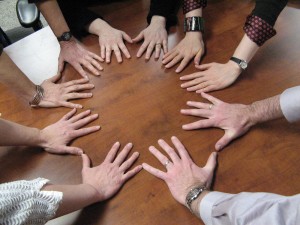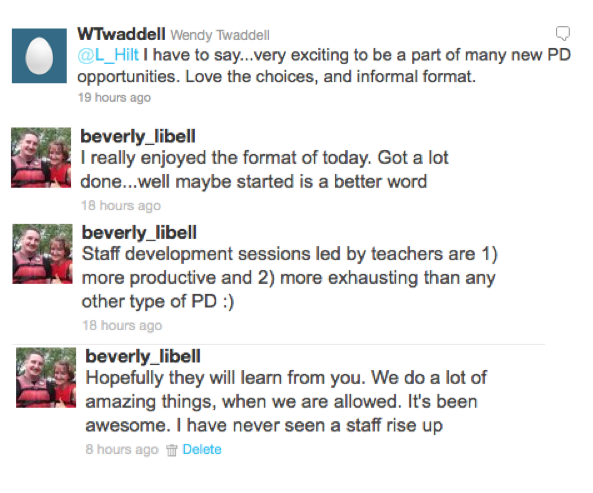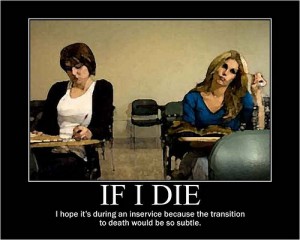For the past two days another elementary principal and I have hosted a variety of teacher candidates in my office for round after round of interviews for long-term substitute teaching positions. These positions are for extended periods of time in order to serve during family leave absences.
That being said, while there is no contract attached to the positions, I would expect as much out of a LTS candidate as I would for a full-time, contracted teacher.
Know this.
A bit about the process:
a) candidates submit complete applications in order to pass the first level of screening- we use the service PA Educator to screen electronic apps according to criteria we set
b) out of the hundreds (yes, hundreds, for one elementary position) that pass the screening, our assistant superintendent reviews apps and sends to the principals for review apps that may be a “good fit” for the open positions
c) principals review paper copies of the candidate’s documentation: resumes, cover letters, reference letters, transcripts; we then narrow the stack and schedule interested candidates for interviews. (Note: I have an incredibly hard time discerning qualities of candidates on paper. GPAs are similar. Canned reference letters are abundant. Extracurriculars are the same. Somehow, work to make yourself shine on paper. Proofread. Twelve times.)
d) at least two admin run the interviews; depending upon length and type of position offered, central office personnel are also involved, and there may be multiple interviews
I didn’t want this post to be about the process. A lot of schools use similar methods to narrow the field of candidates. I wanted this post to be about the quality of responses I received from candidates in our interviews.
Since I was the host, I selected the questions. A few years ago our administrative team read James Stronge and Jennifer Hindman’s The Teacher Quality Index: A Protocol for Teacher Selection and worked together to develop an interview protocol for our district, including sample questions for five domains: The Teacher as a Person, Classroom Management and Organization, Planning for Instruction, Implementing Instruction, and Monitoring Student Progress and Potential. Each question’s intent is outlined, with ideal responses summarized, and rubrics guide “scoring” of candidate responses. There is a writing sample included in the protocol, as well as providing the candidate with a “prerequisites of effective teaching score.” This pertains to how experienced the candidate is, the level of professionalism exhibited, etc.
Not surprisingly, the majority of my questions came from the “Teacher as a Person” category.
That’s what I’m looking for. Genuine people.
Here are some highlights and lowlights. If you are a teacher candidate, please, read and reflect upon your current preparedness to impress your interviewers. If you are someone who works with pre-service teachers, I implore you to pass along my sentiments. Not every administrator and school is looking for the same thing. I understand that. But even my colleague and I, who have very different building climates and who were seeking different qualities in our new hires, could agree on the strengths and needs of those before us.
The Highs
- When asked about ideal physical space for a classroom, nearly all candidates indicated the desire for students to be grouped in order to facilitate collaboration, communication, and teamwork. One candidate mentioned that group work helps students “build knowledge together.” I loved that. Many mentions of cozy spaces where kids can enjoy independent reading and learning.
- Positive reinforcements shone through as ways to “manage” a classroom. There was not a lot of talk about elaborate systems for classroom management, or discipline.
- Many mentions of the importance of building community and getting to know students on a personal level in order to be successful.
The Lows
- Lack of elaboration with responses. Please provide concrete examples of how this looks in your classroom, or how it would look. Paint me a picture. Even if I don’t get time to look through your portfolio, ask if I want to see it. One of the candidates actually left her portfolio with us, and included a self-addressed, stamped envelope for us to return it to her. Genius- although, better yet, give me the link to your online portfolio.
- Too many buzzwords, some of which included: differentiation (I throw up in my mouth a little when I hear that, UNLESS you proceed to tell me what that looks like and why you would use such a word in the first place); think-pair-share, guided reading, manipulatives, blah blah.
- A general “Technology is so important for kids today” notion, but not being able to articulate meaningful uses for technology in the classroom.
- When the opportunity arises to ask the interviewers questions, don’t ask anything you can find on the website or principal’s blog. I enjoyed this question: “How would you describe your school community in one or two sentences?” Happy to do so.
- A disheartening observation: When asked to describe an instance when the candidate had difficulty with a particular child’s behavior and how it was approached, within seconds of beginning the response, there was a mention of the child’s diagnosis: ADHD, ES, Asperger’s, etc. Guess what? I don’t care what the diagnosis is. I want to learn how you responded to the needs of the child and best supported her as demonstrated by her behaviors. Done.
- Since I’m me, I asked: “Outside of taking formal courses through college or graduate programs, what are some things you do to help you grow and stay current as a professional?” Typical responses: I read professional books. I read articles. I listen in the faculty room when other teachers are discussing education. (I am quite skeptical of the quality of those discussions 🙂 Since I sub, I get to learn about a lot of different programs and methods. Okay. So now what? Who are you going to talk to about the things you’re learning? There were zero responses that indicated any level of professional connectedness. One person mentioned going online to find ideas – but not to connect with others. We need to get our teachers connected.
- A general lack of passion. Can some of that be attributed to nerves? Meh, maybe. Practice your responses. Talk to yourself in the mirror. This will help the nerves subside.
For the love of God, be emotional with me. Show me you want to be with my kids. Tell me. Tell me all about the activities you’ll do together. Give me details. Share your ideas with me. I won’t think you’re crazy. Be passionate in your responses. If I have to wonder, for one second, if you love kids? You’re not going to be offered a position. I can teach you programs. I can develop your content knowledge. I probably can’t transform you into a human being who loves being a teacher if you don’t inherently love doing so.
Passion is necessary. Don’t make me request your emotions -provide them, in every word, every response, every example of why you want to teach in my school.














